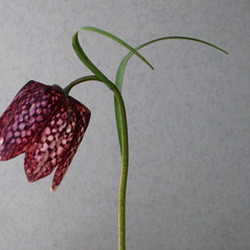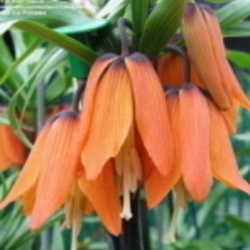 Crown Imperials are members of the lily family and grow to a height of about three feet. Leaves are lance-shaped, glossy, and appear at intervals along the stem. Toward the top of the stem a prominent whorl of five to nine bell-shaped, downward facing flowers appears, topped by a crown of small leaves that looks somewhat like the top of a pineapple. Crown Imperials are members of the lily family and grow to a height of about three feet. Leaves are lance-shaped, glossy, and appear at intervals along the stem. Toward the top of the stem a prominent whorl of five to nine bell-shaped, downward facing flowers appears, topped by a crown of small leaves that looks somewhat like the top of a pineapple.
Soil Condition is Important
Like other fritillaries, Crown Imperials prefer a temperate climate (zones 5a through 8b), loose, well-drained soils with even moisture while they're growing, then fairly dry conditions when the tops die down. To simulate these conditions more nearly, try mulching the bulbs as the stems emerge in the spring, making sure that the soil  underneath is moist. Then remove the mulch after flowering. In heavy soils, Crown Imperials struggle to survive, often withering quickly or rotting before the foliage emerges in the spring. If you garden in clay soil, try growing these magnificent plants in raised beds filled with loose, somewhat sandy soil. Failing that, Crown Imperials are stunning grown in large pots and planters, where you can control the composition of the soil (cactus soil works well) and its drainage (pots with one large drainage hole or several smaller ones). underneath is moist. Then remove the mulch after flowering. In heavy soils, Crown Imperials struggle to survive, often withering quickly or rotting before the foliage emerges in the spring. If you garden in clay soil, try growing these magnificent plants in raised beds filled with loose, somewhat sandy soil. Failing that, Crown Imperials are stunning grown in large pots and planters, where you can control the composition of the soil (cactus soil works well) and its drainage (pots with one large drainage hole or several smaller ones). Plant, Wait for Spring, and be Dazzled
The baseball-sized bulbs should be planted about six inches deep in September or October, as soon as you receive them. Choose a site that gets full sun in the spring. You may be surprised to find that the bulb  has a hole going all the way through it from top to bottom. This is normal and doesn't affect its viability. If there is no hole, just an indentation in the top of the bulb, it's very important to plant that bulb on its side, so that water doesn't collect in the depression and rot the bulb. The bulbs will flower for a full month the following April or May, depending on the zone in which you garden. You don't need a lot of bulbs to make a big show. The flowers are so unusual and striking that it only takes three bulbs to create a nice display. Use them to create a focal point surrounded by other spring flowering bulbs. They make an excellent companion for the mid-season tulips, daffodils, and hyacinths. has a hole going all the way through it from top to bottom. This is normal and doesn't affect its viability. If there is no hole, just an indentation in the top of the bulb, it's very important to plant that bulb on its side, so that water doesn't collect in the depression and rot the bulb. The bulbs will flower for a full month the following April or May, depending on the zone in which you garden. You don't need a lot of bulbs to make a big show. The flowers are so unusual and striking that it only takes three bulbs to create a nice display. Use them to create a focal point surrounded by other spring flowering bulbs. They make an excellent companion for the mid-season tulips, daffodils, and hyacinths. What's that funky fragrance?
OK, here's the small print. Crown Imperials come with two disclaimers. One concerns the fragrance, which is perhaps best called an odor. Gardeners have variously described it as a combination of wet fur and garlic, phenolic, putrid, sulfurous, sweaty, and foxy. To my nose it's definitely skunky. The smell is stronger when the stems are emerging and when the wind is blowing. Any disturbance of the leaves will release the odor. As the plant matures, the odor abates to the point where  it's not detectable unless you put your nose right up against a leaf. The flowers have no discernible fragrance. As I write this sentence, I have just returned from a garden sniff test. The orange Fritillaries currently have no fragrance at all (even when I disturb the leaves) and the yellow ones smell only slightly when I put my nose next to a plant. These are not plants that will "perfume" your whole garden with an overpowering fragrance, so a slightly skunky aroma now and then when I work in the vicinity of the plants has not deterred me in the least from growing them. What the smell does deter is the presence of moles, mice, and other rodents. Even deer will avoid them. While we have an abundance of moles and deer in the area, none of them has ever come near a bed with Crown Imperials in it. it's not detectable unless you put your nose right up against a leaf. The flowers have no discernible fragrance. As I write this sentence, I have just returned from a garden sniff test. The orange Fritillaries currently have no fragrance at all (even when I disturb the leaves) and the yellow ones smell only slightly when I put my nose next to a plant. These are not plants that will "perfume" your whole garden with an overpowering fragrance, so a slightly skunky aroma now and then when I work in the vicinity of the plants has not deterred me in the least from growing them. What the smell does deter is the presence of moles, mice, and other rodents. Even deer will avoid them. While we have an abundance of moles and deer in the area, none of them has ever come near a bed with Crown Imperials in it. Disclaimer number two: The bulbs are pricey. A number of online and catalog bulb sellers carry Crown Imperial, but it pays to check the price closely. My survey of Internet offerings yielded the following results: One bulb may range in price from $9.95 to as low as $4.00. The lower prices are for a quantity of five. Most sites don't list bulb size, so it's important to ask before you buy. Interestingly, the the $4.00 bulb (when purchasing 5 bulbs) is offered by Colorblends, a reputable source. It was also the only source that mentioned bulb size (baseball). For other sources, consult our DG PlantScout. When you consider the beauty Crown Imperials bring to your garden and the fact that they effectively repel varmints, the price is well worth it.  When the Blossoms are Gone When the Blossoms are Gone
After blooming, the tops die down quite quickly, early enough to be mostly hidden by taller perennials emerging around them. Once the tops have yellowed, you can cut them off at soil level. Mark the location of the bulbs to avoid any damage when digging or raking. If they like the growing conditions you have provided, every bulb will eventually produce two or three stems, and each of these will produce a large bulb. You can choose to allow a sizable colony to build up over the years (photo at left), or you can dig some of the bulbs in fall and replant them in another location.
Other Fritillaria Species
Fritillaria species number about 30. Below are a few worthy of your acquaintance. Mouse over each photo for the plant's botanical moniker.
|
 As befits a member of royalty, the Crown Imperial's history can be traced back over many centuries. Originating in the drier regions of Turkey, Iraq, Afghanistan and into the foothills of the Himalayas, it was introduced to Europe by
As befits a member of royalty, the Crown Imperial's history can be traced back over many centuries. Originating in the drier regions of Turkey, Iraq, Afghanistan and into the foothills of the Himalayas, it was introduced to Europe by  Crown Imperials are members of the lily family and grow to a height of about three feet. Leaves are lance-shaped, glossy, and appear at intervals along the stem. Toward the top of the stem a prominent whorl of five to nine bell-shaped, downward facing flowers appears, topped by a crown of small leaves that looks somewhat like the top of a pineapple.
Crown Imperials are members of the lily family and grow to a height of about three feet. Leaves are lance-shaped, glossy, and appear at intervals along the stem. Toward the top of the stem a prominent whorl of five to nine bell-shaped, downward facing flowers appears, topped by a crown of small leaves that looks somewhat like the top of a pineapple.  underneath is moist. Then remove the mulch after flowering. In heavy soils, Crown Imperials struggle to survive, often withering quickly or rotting before the foliage emerges in the spring. If you garden in clay soil, try growing these magnificent plants in raised beds filled with loose, somewhat sandy soil. Failing that, Crown Imperials are stunning grown in large pots and planters, where you can control the composition of the soil (cactus soil works well) and its drainage (pots with one large drainage hole or several smaller ones).
underneath is moist. Then remove the mulch after flowering. In heavy soils, Crown Imperials struggle to survive, often withering quickly or rotting before the foliage emerges in the spring. If you garden in clay soil, try growing these magnificent plants in raised beds filled with loose, somewhat sandy soil. Failing that, Crown Imperials are stunning grown in large pots and planters, where you can control the composition of the soil (cactus soil works well) and its drainage (pots with one large drainage hole or several smaller ones).  has a hole going all the way through it from top to bottom. This is normal and doesn't affect its viability. If there is no hole, just an indentation in the top of the bulb, it's very important to plant that bulb on its side, so that water doesn't collect in the depression and rot the bulb. The bulbs will flower for a full month the following April or May, depending on the zone in which you garden. You don't need a lot of bulbs to make a big show. The flowers are so unusual and striking that it only takes three bulbs to create a nice display. Use them to create a focal point surrounded by other spring flowering bulbs. They make an excellent companion for the mid-season tulips, daffodils, and hyacinths.
has a hole going all the way through it from top to bottom. This is normal and doesn't affect its viability. If there is no hole, just an indentation in the top of the bulb, it's very important to plant that bulb on its side, so that water doesn't collect in the depression and rot the bulb. The bulbs will flower for a full month the following April or May, depending on the zone in which you garden. You don't need a lot of bulbs to make a big show. The flowers are so unusual and striking that it only takes three bulbs to create a nice display. Use them to create a focal point surrounded by other spring flowering bulbs. They make an excellent companion for the mid-season tulips, daffodils, and hyacinths.  it's not detectable unless you put your nose right up against a leaf. The flowers have no discernible fragrance. As I write this sentence, I have just returned from a garden sniff test. The orange Fritillaries currently have no fragrance at all (even when I disturb the leaves) and the yellow ones smell only slightly when I put my nose next to a plant. These are not plants that will "perfume" your whole garden with an overpowering fragrance, so a slightly skunky aroma now and then when I work in the vicinity of the plants has not deterred me in the least from growing them. What the smell does deter is the presence of moles, mice, and other rodents. Even deer will avoid them. While we have an abundance of moles and deer in the area, none of them has ever come near a bed with Crown Imperials in it.
it's not detectable unless you put your nose right up against a leaf. The flowers have no discernible fragrance. As I write this sentence, I have just returned from a garden sniff test. The orange Fritillaries currently have no fragrance at all (even when I disturb the leaves) and the yellow ones smell only slightly when I put my nose next to a plant. These are not plants that will "perfume" your whole garden with an overpowering fragrance, so a slightly skunky aroma now and then when I work in the vicinity of the plants has not deterred me in the least from growing them. What the smell does deter is the presence of moles, mice, and other rodents. Even deer will avoid them. While we have an abundance of moles and deer in the area, none of them has ever come near a bed with Crown Imperials in it. When the Blossoms are Gone
When the Blossoms are Gone































